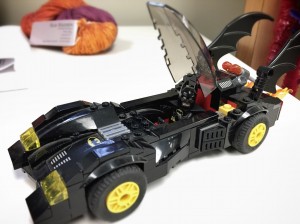My husband, Jon, likes Legos. A lot. I admit: building my very own Batmobile was pretty sweet. (You are welcome to come see it in my office any time.) But we diverge in our process for building. While I like to follow the directions, look at the diagrams, and compare to the pictures on the box, he just dumps everything out in a pile and gets to it, with some helps from our cats.
Even with these different approaches, Jon’s creations arrive at the same place as mine. But that is because he has spent a (embarrassingly) large amount of his time putting together Legos. He understand the purposes of the different pieces and has an idea of how to put something together before he even started. My first Lego creation was maybe two years ago and I’ve made few since then. Everything about them is foreign to me and I need to depend on the guidance from the instructions, the pictures, and my expert husband. Writing, for our students, is no different.
We are experts in our respective fields. Along with that expertise comes knowledge of disciplinary specific writing standards, styles, and expectations. Depending on the task, we may need no instruction to be successful – I’m sure we can all write emails to a variety of audiences without needing much assistance. Our students, however, are apprentices to the field. They do not yet understand what is required of them in different writing situations. That’s where models and outlines come in.
Outlines work for students like the directions in a box of Legos. They provide steps in the process of organizing a paper. Some of these steps might be optional and some of them might hinge on a correct order. When you provide an outline to students, you are giving them some direction and guidance in the process of writing the paper.
Models are similar to outlines, but less explicit. However, they assist in providing a nice big-picture of what the final product might look like. The pictures on a Lego box don’t tell me what exactly to do, but they do assure me that my final creation looks the way it should. Models help students to see their end goal and shape their papers to fit within the project’s and discipline’s standards.
Additionally, models (and general outlines) help students “off road” successfully. Jon is able to make his own Lego house based on all the different types of houses he has made. He knows what is needed and what can be skipped. A large variety of models will allow students to see the different ways a task is achieved and gives them a space in which to make choices about what they want to include and what isn’t needed. Most outlines we give in composition classes acknowledge “best” approaches, but we’re quick to tell students that if their topics don’t fit the outlines, then they can use a different method. This keeps outlines from becoming a crutch; instead, they remain an important guide, with room for exploration.
Both of these supports can be as detailed or sparse as needed. New tasks may require more detailed outlines and more model examples, whereas later projects may require less, if any at all. Jon doesn’t need to read the directions on simple projects, but when he skips the directions on a complicated project the end result isn’t pretty. Trust me.
So far we’ve looked at some ways to help students produce more effective writing, such as creating stronger assignments and scaffolding within those assignments. In the final article of this series, we’ll wrap up by looking at how transparency in assessment is good for both us and our students.
(See also My students can’t write! Part 1: Crafting Effective Writing Assignments; My students can’t write! Part 2: Scaffolding; and My students can’t write! Part 4: Grading and Rubrics.)


